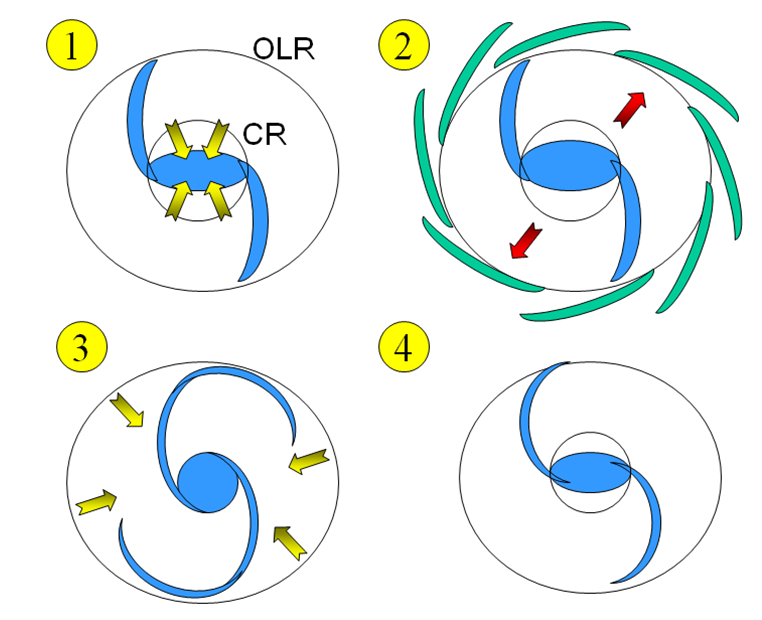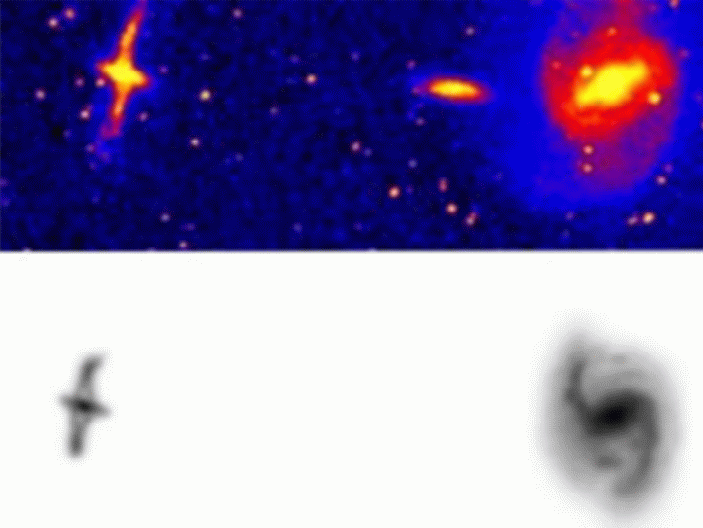|
|
Angular momentum transfer inside a single galaxy, Bars, warps, polar rings
Main topics
- Stability of stellar and gaseous disks in primordial galaxies

|
Left: Clumpy galaxies, in the early universe. The spiral and regular structure disappears.
When edge-on, the clumps look like a chain (images from the HST-UDF, Ultra Deep Field observations).
Right: Simulations of galaxies constituted with at least 50% of gas. The disk is dynamically cold, and highly unstable against gravitational
collapse into clumps. Progressively, clumps are driven into the centre by dynamical friction, and form a bulge, which stabilises the disk
(Bournaud et al 2007).
We will take into account the details of the baryonic physics, beyond what has been done so far,
cooling to molecular cloud temperatures, resolving out giant molecular clouds, including
chemical enrichment, to provide observational diagnostics.
|
- Secular evolution and bar cycle at high redshift
|
Bar cycle, in fours steps: (1) In a first step, a bar-spiral wave develops through gravitational instability. The central bar exerts a torque
on the gas, which follows the wave with a phase shift, due to its dissipative character. The gas inside corotation (CR) is driven inwards, and piles up at the inner Lindblad resonance (ILR). (2) in the mean time, the gas outside CR is driven outwards, and piles up at the outer Lindblad resonance (OLR).
(3) the gas inflow to the center was possible, since it gave all its angular momentum to the bar. The bar is a wave of negative
angular momentum, and when accepting this momentum, it weakens. As soon as the disk of the galaxy is devoid of a strong bar,
the gas that was confined outside OLR can now flow inwards. The disk now cools down, since the gas has a low velocity
dispersion, and becomes unstable against another barred instability (4). During the cycle, the mass concentration increases, now the bar
rotates faster, and is shorter, since it ends at its corotation.
We want to check all new possible phenomena relevant to the primordial galaxies, and
understand the correlation between the colour bimodality and bar frequency.
|

|
- Angular momentum exchange with dark matter haloes

|
Influence of the gas content and bulge mass on bar strength in galaxies embedded in a massive live dark matter halo
(left type Sb, and right type Sd, with no bulge).
The top (black) curves are models without gas, then the 3 lower curves are with gas but no external accretion, then more or less gas accretion. Note how the bar strength drops around 2 Gyr due to peanut instability, then increases again, exchanging angular momentum with the halo (Combes 2008b).
More simulations have to be run to understand how many key parameters are involved.
The outcome will enlighten not only the precise influence of dark matter haloes (and their cuspy/core morphology) on bar evolution,
but also the evolution speed as a function of redshift, and the downsizing phenomenon.
|
- Exponential disk formation, Radial mixing and chemical evolution
|
Results of a Tree-SPH simulation, studying the exchange of angular momentum
due to resonance overlap of bar and spiral waves.
Top row: Stellar disk density contours of a giant Sa galaxy in 5 snapshots.
Middle row: Changes in angular momentum, Delta_L as a function of the
initial angular momentum, L_0. The locations of the
bar CR and OLR are indicated by the dotted and solid lines, respectively.
Bottom row: The evolution of the radial profiles of surface density (left) and
metallicity (right) for the stellar and gaseous disks.
The initial disk scale-lengths are indicated by the solid lines. The 5 time steps
shown are as in the Top row, indicated by solid red, dotted orange, dashed green,
dotted-dash blue and solid purple, respectively,
from Minchev et al (2010).
We will make a detailed inventory of the amount of angular momentum so transferred to trace the history of the galaxies.
|

|
- Accretion from filaments, reorientation of disks, formation of warps and polar rings

|
The prototype of polar ring galaxy NGC 4650A. The polar ring (left) is formed via tidal accretion of material from the gas-rich spiral
(right, now isolated). The simulated model (bottom) matches the relative velocities of the actual system (top, DSS image) and
predicts and age of 400 Myr (credit F. Bournaud).
Since polar rings are easy-to-observe signatures of the mass assembly, and angular momentum re-distribution, we will simulate this in detail, to make robust statistical predictions.
Also we will, for the first time, monitor the occurence of gaseous warps in large volumes, and predict the resulting frequency from "observed" simulations.
|
|

